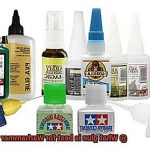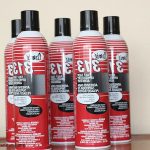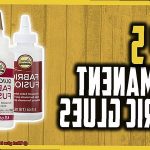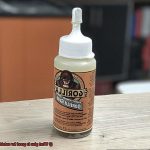Love getting your hands dirty with sizzling hot DIY projects? Whether you’re jazzing up your kitchen, pimping out your ride, or unleashing your artistic genius, adhesive glue is the ultimate sidekick. But what happens when you’re working with materials that can’t handle the heat? Fear not. Today, we’re diving into the world of heat resistant glues and uncovering their superpowers for all you creative souls out there.
When regular glues start melting under pressure, these bad boys step up to the plate, standing strong against scorching temperatures without losing their grip. But which glues are truly heat resistant? And which materials do they work best on? Join us as we dig deep into the traits, uses, and perks of high heat resistant glues. We’ll arm you with all the knowledge you need to conquer any project that’s got a fiery twist.
Get ready to unlock a whole new level of adhesive awesomeness and take your craftsmanship to a temperature-resistant paradise. Stick around (pun intended) and embark on an adhesive adventure like never before.
What is Epoxy Adhesive?
Contents
- 1 What is Epoxy Adhesive?
- 2 Benefits of Using Epoxy Adhesive
- 3 What is Silicone-Based Adhesive?
- 4 Benefits of Using Silicone-Based Adhesive
- 5 What is Polyurethane Adhesive?
- 6 Benefits of Using Polyurethane Adhesive
- 7 Factors To Consider When Choosing High Heat Resistant Glue
- 8 Proper Application and Curing for Maximum Heat Resistance
- 9 Conclusion
Epoxy adhesive is a remarkable bonding agent that stands out from other glues due to its exceptional strength, durability, and heat resistance. Composed of two components – a resin and a hardener – epoxy adhesive is widely used in industries such as automotive, aerospace, construction, and electronics.
The most notable characteristic of epoxy adhesive is its ability to withstand high temperatures without losing its bond. While many glues may melt or weaken when exposed to heat, epoxy adhesive remains stable and continues to provide a strong hold. This makes it an ideal choice for applications where heat resistance is crucial, such as bonding metal parts in engines or electronics that generate significant heat.
Beyond its impressive heat resistance, epoxy adhesive also offers excellent chemical resistance. It can endure exposure to a wide range of chemicals, including acids, solvents, and oils, without deteriorating or losing its adhesive properties. This makes it suitable for use in environments where the adhesive may come into contact with different substances.
Moreover, epoxy adhesive is known for its exceptional strength once cured. It forms a rigid bond that can withstand heavy loads and vibrations, making it suitable for applications requiring a strong and durable bond. Whether it’s bonding structural components or repairing cracked surfaces, epoxy adhesive provides a reliable solution that can withstand the test of time.
Additionally, the versatility of epoxy adhesive sets it apart from other glues. It can be used on various materials such as metals, plastics, ceramics, and composites. This flexibility makes it a popular choice in industries where different materials need to be bonded together.
However, achieving optimal bonding with epoxy adhesive requires proper surface preparation. The surfaces being bonded must be clean, dry, and free from any contaminants or coatings that could hinder adhesion. Additionally, following the precise mixing ratio of the resin and hardener is essential for proper curing and bonding strength.
Benefits of Using Epoxy Adhesive
Today, we dive into the world of epoxy adhesive and explore its superpowers in high-temperature applications. From industrial settings to everyday repairs, epoxy adhesive stands tall as the ultimate hero, offering unmatched strength, versatility, and durability. So buckle up and get ready to discover the benefits of using this mighty glue when the heat is on.
Imagine a glue that can withstand extreme temperatures without breaking a sweat – that’s epoxy adhesive for you. With a temperature range from -60°C to 200°C, this adhesive is tailor-made for industries like automotive, aerospace, and electronics where high temperatures are an everyday challenge. Whether it’s under the hood of a car or inside a spaceship, epoxy adhesive fearlessly holds its ground, maintaining its bond integrity even in scorching conditions.
In high-temperature environments, exposure to harsh chemicals can be a constant threat. But fear not. Epoxy adhesive acts as a protective shield, offering excellent chemical resistance. It can withstand oils, fuels, solvents, and other harsh substances without degradation. So whether you’re dealing with corrosive acids or aggressive solvents, epoxy adhesive has got your back.
When it comes to bonding strength, epoxy adhesive is in a league of its own. It forms an unbreakable bond with various substrates such as metals, plastics, ceramics, and composites. This exceptional bond strength is vital in applications that experience thermal cycling or constant exposure to high temperatures. No matter how much materials expand or contract due to temperature fluctuations, epoxy adhesive ensures that the bond remains intact and reliable.
In high-temperature applications involving electrical components, epoxy adhesive shines as a superhero. Its excellent electrical insulation properties prevent leakage or short circuits, even under extreme heat conditions. It effectively insulates conductive materials, providing a reliable and safe environment for electrical systems to operate.
In the face of temperature fluctuations, epoxy adhesive maintains its shape and size. This dimensional stability ensures that the bond remains strong and intact over time. So whether it’s a cold winter night or a scorching summer day, you can trust epoxy adhesive to keep everything together.
Epoxy adhesive is like a chameleon, adapting to different requirements. It can be formulated to have various properties, such as fast cure time, low viscosity for easy application, or flexibility for applications requiring some degree of movement. Whatever your specific needs may be, epoxy adhesive has the solution.
Moisture and humidity are no match for epoxy adhesive. It boasts good resistance to these elements, further enhancing its durability in challenging environments.
What is Silicone-Based Adhesive?
In the realm of glues, one stands tall and unyielding – silicone-based adhesive. With its unparalleled resistance to heat, flexibility, durability, and ability to defy moisture and chemicals, this adhesive is a true force to be reckoned with. Journey with us into the world of silicone-based adhesive and discover why it has become the go-to choice for numerous industries.
The Power of Heat Resistance:
Silicone-based adhesive possesses an extraordinary power – the ability to endure extreme temperatures from -60°C to 300°C (-76°F to 572°F). This superpower makes it the perfect choice for applications in environments where other adhesives would falter. Whether it involves bonding metal components in engines or sealing electronic devices exposed to scorching heat, silicone-based adhesive never backs down from its duty.
Flexibility and Durability:
Not only does silicone-based adhesive showcase exceptional heat resistance, but it also offers unparalleled flexibility and durability. It can withstand the expansion and contraction caused by dramatic temperature fluctuations without compromising its adhesive properties. This makes it an ideal choice for materials that experience thermal stress, such as unyielding metals, delicate ceramics, and fragile glass.
Defying Moisture and Chemicals:
Another remarkable power held by silicone-based adhesive is its resistance to moisture and chemicals. Its excellent water repellency ensures that it remains intact even when submerged in water or exposed to high humidity levels. Additionally, it can bravely face a wide array of chemicals, including harsh oils, potent solvents, aggressive acids, and potent bases. This makes it a reliable choice for applications that demand resistance against corrosive substances or harsh environmental conditions.
Forms for Every Need:
Silicone-based adhesive comes in various forms tailored to meet different requirements. Liquid adhesives are perfect for bonding vast surfaces or filling gaps, while gels and pastes excel in situations where controlled dispensing or vertical bonding is necessary. Silicone adhesive tapes are commonly employed for sealing or wrapping applications, providing a secure shield against the elements.
Benefits of Using Silicone-Based Adhesive
When it comes to high-temperature applications, one adhesive rises above the rest – silicone-based adhesive. With its exceptional heat resistance and a plethora of other desirable properties, silicone-based adhesive has become a superhero in the world of adhesives. Let’s dive into the benefits of using this remarkable adhesive in high-temperature applications and explore some specific examples where it truly shines.
Unmatched Heat Resistance:
Silicone-based adhesives are like the invincible shield against extreme temperatures, withstanding scorching heat ranging from -60°C to over 300°C. While other adhesives crumble and fail under high temperatures, silicone adhesives remain stable, ensuring reliable bonding even in the harshest heat conditions.
Enduring Bond Strength:
In the face of rapid temperature variations, silicone-based adhesives stand firm, refusing to let go. Their excellent resistance to thermal cycling ensures that your materials stay securely bonded, regardless of temperature fluctuations. No matter how hot or cold it gets, the bond remains unbreakable.
Resilience in Aging:
Time may be an enemy to some, but not to silicone-based adhesives. They do not succumb to the ravages of heat exposure, remaining flexible and strong even after years of service. This resilience makes them a durable choice for long-term applications, saving you time and money on frequent repairs and replacements.
Versatility:
Silicone-based adhesives are like chameleons, effortlessly adapting to the needs of various industries and applications. In the automotive manufacturing world, they brave the intense heat generated by engines and exhaust systems. They also find their place in aerospace, electronics, and industrial settings where high temperatures are prevalent. No matter the battlefield, silicone-based adhesive is ready for the challenge.
Wide Range of Substrate Compatibility:
Silicone-based adhesives are like the glue that brings different worlds together. They can bond with diverse substrates such as metals, plastics, glass, ceramics, and composites. This remarkable versatility opens up a world of possibilities for bonding applications across different industries, allowing for seamless integration between various materials.
Enhanced Properties:
Silicone-based adhesives are more than just heat-resistant warriors. They possess an array of additional superpowers such as flexibility, chemical resistance, and excellent electrical insulation. These attributes further enhance their suitability for demanding applications where other adhesives may fall short. They provide the extra strength and protection needed to conquer any challenge.
What is Polyurethane Adhesive?
Imagine you’re working on a project that demands an adhesive with Herculean strength, capable of enduring scorching temperatures and delivering a bond that stands the test of time. Enter polyurethane adhesive, the true superhero of adhesives.
Polyurethane adhesive, or PU adhesive for short, is forged from the mighty power of polyurethane polymers. Now, I know what you’re thinking, “poly-what?”. Fear not, dear friend, for I shall guide you through this realm of wonder. Polyurethane polymers are birthed through a captivating chemical reaction between polyols and isocyanates. This union gives rise to a formidable adhesive compound that laughs in the face of heat-induced adversity.
Behold, one of the great powers of polyurethane adhesive: its unwavering strength and adhesion even in the face of blistering temperatures. Whether your domain lies within the automotive, aerospace, or industrial realm, this adhesive is your unwavering ally. It is perfect for joining components that will be subjected to extreme temperatures or rapid thermal fluctuations.
But hold onto your hats, there’s more. Polyurethane adhesive also boasts unparalleled chemical resistance and flexibility. It can bind a vast array of materials with ease – metals, plastics, composites, even wood. Talk about versatility.
Now, let’s dive into the various forms of this adhesive superhero. You have your one-component and two-component varieties. The one-component adhesive leaps into action straight from the bottle, ready to fulfill its destiny. Meanwhile, its two-component counterpart necessitates the harmonious blending of separate resin and hardener components before it unleashes its might upon your project. The choice rests in your hands, dependent on your specific needs and desired curing time.
But remember, even superheroes require preparation before they save the day. Adequate surface preparation is key to achieving optimal bonding strength. Ensure those surfaces are pristine – free from the clutches of oil, dust, or any other nefarious contaminants. Some formulations may even call for the application of a primer to enhance adhesion.
Once applied, polyurethane adhesive embarks upon a grand journey of curing through a mystical process called cross-linking. This process weaves intricate chemical bonds between the polymer chains within the adhesive, birthing a bond that is unyielding and indomitable.
Benefits of Using Polyurethane Adhesive
Polyurethane adhesive is a superhero in the world of adhesives, offering a multitude of benefits that make it the go-to choice for all your bonding needs. From its exceptional heat resistance to its versatility and durability, this adhesive has got it all covered.

First and foremost, let’s talk about heat resistance. With the ability to withstand temperatures ranging from -40°C to 150°C, polyurethane adhesive can handle even the most extreme heat conditions. Whether you’re working under the scorching sun or in a manufacturing plant with high temperatures, this adhesive won’t let you down. Its strength and bonding properties remain intact, making it a top choice for industries like automotive and aerospace.
But that’s not all – polyurethane adhesive is also a master of bonding. It forms a strong and durable bond with various materials such as metals, plastics, wood, and composites. No matter what material you’re working with, this adhesive has got your back. It even provides excellent adhesion in high-temperature environments, ensuring long-lasting and reliable bonding.
Chemical exposure got you worried? Fear not. Polyurethane adhesive is resistant to oils, fuels, acids, and alkalis. It can withstand exposure to all sorts of chemicals without degrading or losing its bond strength. This makes it a preferred choice for applications where chemical resistance is crucial.
And let’s not forget about moisture and water resistance. Polyurethane adhesive doesn’t crumble when faced with humidity or wet environments. So whether you’re working on an outdoor project or dealing with water contact, this adhesive will stay strong.
Flexibility is another superpower of polyurethane adhesive. It can absorb vibrations and shocks, making it perfect for applications involving movement or dynamic loads. Say goodbye to cracks and joint failures.
Now, let’s talk versatility. Polyurethane adhesive can do it all – bonding, sealing, and encapsulating. It’s widely used in industries like automotive, construction, electronics, and furniture manufacturing. With its ability to handle different applications, this adhesive is a true jack-of-all-trades.
Lastly, durability is key. Once cured, polyurethane adhesive forms a strong and permanent bond that can withstand harsh environmental conditions and temperature fluctuations. Say goodbye to adhesive failures and hello to long-term performance.
Factors To Consider When Choosing High Heat Resistant Glue
Choosing the right high heat resistant glue requires careful consideration of several factors. To ensure a strong and durable bond that can withstand extreme temperatures, keep the following factors in mind:
- Temperature Resistance: Check the product specifications to ensure that the glue can handle the specific temperatures you’ll be exposing it to. Different glues have different temperature limits, so choose one that can withstand the highest temperature your project requires.
- Bonding Strength: Look for glues specifically designed for high heat applications and offering strong bonding capabilities. Consider the materials you’re working with and choose a glue that can create a strong bond between them, especially if you’re using heavy-duty materials or working in demanding environments.
- Application Method: Consider the application method that best suits your project. Liquid glues provide versatility and precise application with brushes or nozzles, while adhesive tapes or sheets offer a mess-free option for larger surface areas.
- Compatibility with Materials: Ensure that the glue is compatible with the materials you’re working with, such as metal, ceramic, glass, plastic, or wood. Check the product specifications or consult with the manufacturer to confirm compatibility.
- Drying Time: If you’re working on time-sensitive projects, consider the drying time of the glue. Some high heat resistant glues require longer drying times, while others offer quick-drying formulas. Choose a glue that strikes a balance between sufficient drying time and quick bonding.
- Chemical Resistance: Depending on your project requirements, choose a glue that can withstand chemical exposure without compromising its bonding strength or integrity. This is important if the glued materials will be exposed to chemicals or if you plan to clean the bonded surfaces with certain substances.
- Flexibility: Select a glue that retains its flexibility even at elevated temperatures, allowing for movement and expansion of bonded materials. This is crucial in applications where there may be thermal expansion or contraction of materials.
Proper Application and Curing for Maximum Heat Resistance
If you’re eager to delve into the world of heat-resistant applications, you’ve come to the right place. In this blog post, we’ll explore the secrets behind proper application and curing techniques that unlock the full potential of high heat resistant glue. So grab your cape and let’s soar into a world of maximum heat resistance.
Surface Preparation:
Before diving into the gluing process, lay a strong foundation by ensuring pristine surfaces. Clean, dry, and contaminant-free bonding areas are vital for a powerful bond. Wipe away any oil, grease, or dust that could undermine the strength of your adhesive.
Adequate Coverage:
To achieve the ultimate in heat resistance, apply the glue evenly, leaving zero room for weakness. Cover every nook and cranny with precision. Embrace the guidance of manufacturer-recommended brushes or applicators to conquer uniform coverage like a seasoned pro.
Recommended Temperature Range:
Just as superheroes have their sweet spot for saving the day, high heat resistant glue has an optimal temperature range for application and curing. Respect these recommendations from the manufacturer—the key to a resilient bond lies within. Straying from these ranges might leave you with a bond vulnerable to extreme temperatures.
Curing Time:
Impatience is not a virtue when it comes to maximum heat resistance. Grant your glue ample time to cure before unleashing it into scorching circumstances. Curing time varies based on environmental conditions and the specific glue being used. By adhering to the manufacturer’s instructions, you’ll forge a bond as unyielding as solid steel.
Heat Activation:
Some high heat resistant glues harbor secret superpowers that require exposure to heat during curing to unleash their maximum strength and resistance. Activate this hidden potential by baking or using a heat gun, but never veer from the manufacturer’s recommendations for optimal results.
Testing:
Before embarking on ambitious projects, put your glue to the test in a controlled environment. Sample a small area to verify bond strength and heat resistance. Skipping this step might leave you vulnerable to mishaps when the heat is on.
mLayFRQ7jdo” >
Conclusion
Glue that can withstand high heat is an essential requirement for many applications. When it comes to bonding materials that will be exposed to extreme temperatures, you need a glue that won’t melt or lose its adhesive properties. Fortunately, there are several options available on the market.
One popular choice is epoxy resin adhesive. This type of glue is known for its exceptional heat resistance, making it suitable for use in high-temperature environments. Whether you’re working with metal, glass, or ceramics, epoxy resin adhesive can provide a strong and durable bond that won’t weaken under intense heat.
Another excellent option is silicone adhesive. Silicone-based glues are renowned for their ability to withstand extreme temperatures without losing their effectiveness. They can handle temperatures as high as 600 degrees Fahrenheit (315 degrees Celsius), making them ideal for applications like automotive repairs or industrial projects.
For even more demanding situations, polyurethane adhesive is a top-notch choice. This type of glue not only boasts impressive heat resistance but also offers excellent chemical resistance and durability. It can handle temperatures up to 300 degrees Fahrenheit (149 degrees Celsius) and provides a reliable bond that won’t let you down.
In conclusion, when searching for a glue that can stand up to high heat, consider options such as epoxy resin adhesive, silicone adhesive, or polyurethane adhesive. These glues offer exceptional heat resistance and reliability in various applications.






